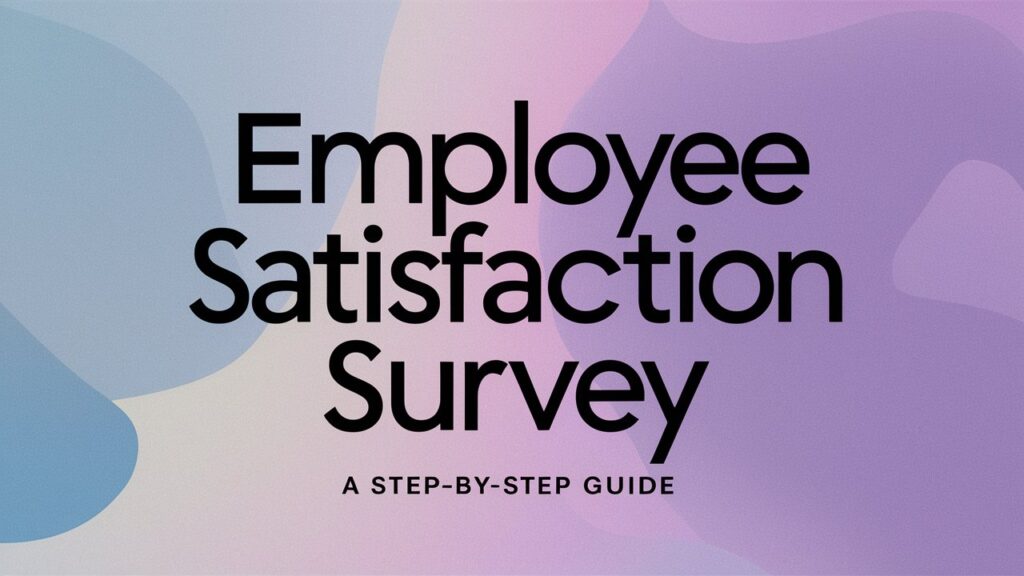This article provides a comprehensive guide to conducting an employee satisfaction survey. Happy employees are key to business success. They’re more productive, engaged, and tend to stick around longer.
A recent Statista, study found that companies with high employee satisfaction score more productivity in work compared to less satisfied employees. Which shows a 12% increase in it.
Try our free AI Survey Questions Generator Today!
Table of content
- What is employee satisfaction
- What is an employee satisfaction survey
- Why should you measure employee satisfaction
- What are employee satisfaction survey questions
- How to do Survey Distribution
- How to do Data Analysis and Action Planning
- Communication and Follow-Up
What is employee satisfaction?
Employee satisfaction is how happy an employee is with their job. It’s about their work environment and organization. It is influenced by many factors:

- Fair pay and good benefits significantly affect employee satisfaction. They get them for their work.
- Balancing work and life is crucial. It keeps employees satisfied.
- A good work environment promotes respect, open communication, and collaboration. It greatly boosts employee satisfaction.
- Employees who see chances for career and skill growth are more likely to be satisfied.
- Recognition and appreciation are crucial in motivating employees and increasing their satisfaction.
Also Read:
- Unlock Feedback Goldmine: Top 9 Free Survey Makers for 2024.
What is an employee satisfaction survey?
An Employee Satisfaction Survey is a formal questionnaire. It is used to gather employee feedback on their work experience. This includes their compensation, work-life balance, company culture, and leadership.

Here are some key benefits of conducting Employee Satisfaction Surveys:
- The survey results can help find areas for improvement in your company. They enable data-driven decisions to improve employee satisfaction.
- Seeking feedback can boost employee engagement. It shows a strong appreciation for their opinions. This leads to more ownership and commitment in the workforce.
- Addressing survey concerns can help create a positive work environment. It reduces employee turnover and retains top talent.
- Research shows a strong link between employee satisfaction and business success. A happy workforce boosts productivity, innovation, and customer satisfaction.
- Unlock Data-Driven Decisions: Craft Winning Market Research Surveys
Why should you measure employee satisfaction?
You might be wondering. “Why do an Employee Satisfaction Survey?” A positive work environment, fueled by happy employees, is essential for a company’s long-term prosperity. Here’s a breakdown of the compelling reasons to measure employee satisfaction:

- Improved Business Performance: Research consistently shows a clear link between employee satisfaction and key business metrics. Satisfied employees are more productive, and engaged, and deliver better customer service. This translates to higher profits and a competitive edge for your company.
- Reduced Turnover: Employee turnover is a costly problem. A discontented workforce is more likely to seek employment elsewhere. You can use surveys to find and fix employee concerns. This will make a happier workplace and keep your valuable talent.
- Enhanced Decision-Making: Employee Satisfaction Surveys provide valuable data-driven insights into your workforce. You understand employee sentiment. You can use the data to make informed decisions. It’s about pay, benefits, work-life balance, and other factors. These things affect employee satisfaction.
- Boosted Employee Morale: When employees feel heard and valued, it leads to a more positive work environment. It also makes work more collaborative. Conducting surveys shows you care about their well-being. It shows you are committed to creating a good work experience.
- Early Identification of Issues: Employee Satisfaction Surveys can act as an early warning system.
Also Read:
- Find Your Perfect Fit: Top 10 Alternatives to SurveyMonkey in 2024
What are employee satisfaction survey questions?
Now you have already seen the importance of measuring employee satisfaction. Let’s talk about the practical steps:

Company Culture
- Do you perceive your contributions to be appreciated by the organization?
- Do you enjoy working with your colleagues?
- Is the company open to employee feedback and suggestions for improvement?
- How well does the company’s mission and values align with your own?
- Would you recommend this company as a great place to work?
Job Satisfaction
- How meaningful and challenging do you find your work?
- Do you feel you have the autonomy and resources to do your job effectively?
- Are your goals and objectives clear?
- Do you receive regular feedback and performance reviews?
- How are you liking your current role these days?
Work-Life Balance
- Do you feel you have a healthy work-life balance?
- Are you able to disconnect from work outside of office hours?
- Does the company offer flexible work arrangements to support your needs?
- How stressed do you typically feel at work?
- Is your workload manageable?
Compensation and Benefits
- Are you satisfied with your current compensation package (salary, bonus, etc.)?
- Do the company benefits meet your needs (health insurance, paid time off, etc.)?
- Do you feel your pay is competitive with the market rate for your position?
- Are there opportunities for raises and promotions within the company?
Management
- Do you feel your manager is supportive and provides clear direction?
- Does your manager value your contributions and provide opportunities for professional development?
- Is there open and honest communication between you and your manager?
- Does your manager create a positive and motivating work environment?
- To what extent does your manager’s leadership style empower you to do your best work?
Professional Development
- Does the company offer training and development? Will they help you grow in your career?
- Are you encouraged to attend conferences, workshops, or other learning opportunities?
- Do you feel your skills are being utilized and developed in your current role?
- Does the company offer clear career paths for your position?
How to do Survey Distribution?
There are several ways to distribute surveys. The best one depends on your target audience and available resources. Let’s explore some common methods:

Choose Your Platform:
- There are numerous normal survey maker and free survey maker tools available in the market. These platforms offer user-friendly interfaces for creating, distributing, and analyzing survey data.
Ensure Anonymity:
- For honest feedback, it’s critical to guarantee employee anonymity. Utilize features offered by your chosen survey platform to ensure confidentiality.
Clear Communication:
- Before starting the survey, tell your employees clearly about its purpose and importance. Explain how their feedback will be used to improve the work environment. Encourage participation and emphasize that anonymity is guaranteed.
Multiple Distribution Channels:
- Consider using a combination of methods to reach all your employees. Use email, internal platforms, or QR codes in the workplace. They provide easy access to the survey.
Set a Deadline:
- Set a clear deadline for the survey. This will ensure you get enough responses.
Also Read:
- The Secret Weapon Loyalty: Craft Winning Customer Satisfaction Surveys
How to do Data Analysis and Action Planning?
Once you’ve collected responses from your Employee Satisfaction Survey, you need to study the data. Then, you’ll turn it into helpful insights. Here’s how to approach this crucial stage:

Data Analysis
Organize and Clean the Data:
- Most online survey maker platforms offer built-in features for data organization and cleaning. This might involve removing incomplete responses or correcting any formatting inconsistencies.
Quantitative Analysis:
- Analyze quantitative data from multiple-choice and Likert scale questions. Calculate statistics. These include averages, medians, and percentages. They help to see trends. They find areas where employee sentiment falls short. Analyze demographic data to identify any variations in satisfaction across different employee groups.
Qualitative Analysis:
- Read through open-ended responses carefully. Identify common themes and recurring issues raised by employees. Look for chances to address concerns. Incorporate feedback for improvement.
Data Visualization:
- Use charts, graphs, and other visual representations to present your findings effectively. This will help communicate key takeaways to stakeholders and facilitate informed decision-making.
Action Planning
Prioritize Issues:
- Based on your data analysis, prioritize the most critical areas for improvement. Consider factors like how severe the issue is and also consider the number of affected employees and the impact on business.
Develop Actionable Strategies:
- For each prioritized issue, brainstorm and develop actionable strategies to address it. This could involve adding new policies. It could also involve providing more resources or it could involve changing existing processes.
Assign Responsibilities:
- Give ownership and responsibility for the action plan to specific people or teams. Make sure all understand their role. Equip them with the resources they need to thrive.
Communication and Feedback Loop:
- Communicate the results of the survey and the planned actions back to your employees. Transparency builds trust and demonstrates your commitment to addressing their concerns.
Track Progress and Measure Impact:
- Set up a system to track your action plans’ progress. Also, monitor how well they work. Consider conducting follow-up surveys to gauge employee satisfaction after implementing changes.
Communication and Follow-Up
Transparent communication is vital to a successful Employee Satisfaction Survey, ensuring employees feel valued and heard. Here’s how to ensure effective follow-up:

- Once you’ve analyzed the data, share the key findings with your employees. Be transparent about both positive and negative feedback.
- Acknowledge the concerns employees raised in the survey. Outline the action plans you’re developing to address them.
- Thank your employees for their participation in the survey. Their feedback is valuable and will be used to improve the work environment.
- Encourage ongoing communication with your employees. Create chances for them to give more feedback. They can also ask questions about the survey results and action plans.
Check out our free survey maker software! Get Beta acccess now.
Conclusion
An Employee Satisfaction survey is a must for every organization. It provides valuable insights into your workforce. It helps you design, distribute, analyze, and use the data from your survey. This data will help you create a better work environment for your employees. Remember, a satisfied workforce is the cornerstone of a successful organization.
Taking action on feedback shows your commitment to employee well-being. It sets your company on a path to lasting growth and success.




